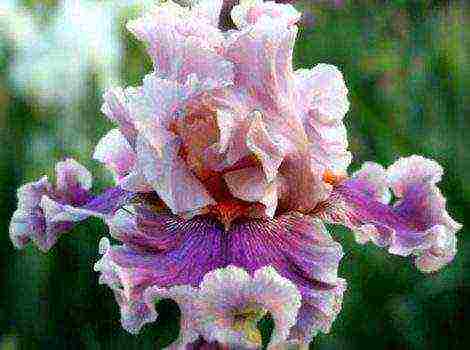Content [show]
The genus Miscanthus or Veernik belongs to the Zlakov family and is a herbaceous perennial plant. The main zones of its distribution in the wild are the tropics and subtropics of Asia and Africa, and some representatives of this genus also grow in Australia.
The height of individuals of various species varies from 80 cm to three meters, although cultivated species and varieties derived from them do not often grow above two meters. The creeping roots of this plant can go 5-6 meters deep into the ground. Its stems are straight, foliage is long, thin. During flowering, it expels spikelets that form panicles on the tops of the shoots. Several species of Miscanthus are grown in our gardens.
Varieties and types
Miscanthus giant breeders say that, apparently, this is a hybrid plant that has formed a long time ago, but its parents have not yet been found out.
Erect shoots of this culture can grow up to 3 meters, foliage up to 30 cm long has a white line in the middle. It blooms in areas with warm summers, the color of the panicles is light scarlet. Most often it is planted on the backs of flower beds, since over time, the lower foliage dies off and bare stems do not create a good impression.
Miscanthus Chinese also has a tall bush of more than two meters. Its root is short, foliage is tough, not very wide.
This species is the most popular of the cultivated, despite not the best winter hardiness. Many varieties are obtained from it:
- Flamingo - a variety with a height of up to two meters, flowers are large, pink.
- Klein Fountain - a little higher than a meter, panicle inflorescences are cast in brown.
- Malepartus - a variety with early flowering, height under 2 meters, burgundy flowers, turn red by autumn.
- Rotsilber - foliage and inflorescences of a red tone, by autumn they acquire an orange tint.
- Zebrina - grows above two meters, foliage is covered with lines of cream color.
- Variegata - this variety has very expressive white lines on the foliage.
Miscanthus sucrose reaches two meters in height, the shoots are bare, the foliage is long, reaching 50 cm. The inflorescences are large, white or with a pinkish tint. Withstands cold well, and since the fan loves warmth, therefore, it begins to develop late.
to the table of contents
Miscanthus planting and care in the open field
Planting miscanthus in open soil begins in the spring from early April. This plant is thermophilic, so the planting site should be well lit and not blown by drafts.
Humidity is also a very important factor.These plants need a lot of water and grow well in wet areas near the shores of water bodies. But excess water in the soil is also unfavorable, since it has a bad effect on germination in spring.
Pennisetum foxtail is also a representative of cereals, you can read the recommendations for growing this plant at the link.
to the table of contents
Soil for miscanthus
In general, the composition of the soil is not so important, but it is better not to plant the plant on heavy clay substrates. In terms of acidity, neutral or slightly acidic soil will be best.
Having decided to plant this plant in your garden, it is better to buy an adult, since young plants simply may not have time to take root due to their warm love.
The site for planting in the fall is dug up and fertilized with organic matter. In the spring, they dig a hole slightly larger than the rhizome of the seedling and carefully lower the plant into it, slightly tamping the substrate. Planting is followed by strong watering.
The main care for miscanthus is abundant watering, which is especially important in the heat.
to the table of contents
Fertilizer for miscanthus
Also, this plant will not mind feeding. In the first year, fertilization is not required, and then this procedure is carried out a couple of times per season.
At the beginning of spring, liquid nitrogen fertilizer is applied, but do not overdo it, as its excess leads to the fact that the shoots lie on the ground.
With the arrival of summer, they are fertilized with humate, and in the second half of the season they are fertilized with fertilizing with potassium and phosphorus.
You also need to constantly remove weeds on the site, at least until the bushes grow and squeeze them out.
It should be noted that miscanthus grows very much and can take over the entire flower bed, so the place of its cultivation must be protected with something, digging in, say, iron 20-30 cm deep.
to the table of contents
Miscanthus winter hardiness
For cold-resistant types of miscanthus, an ordinary shelter made of dry foliage will suffice, but for those that do not tolerate cold, additional insulation should be built, which consists of mulch, oilcloth placed so that air and a pair of wooden shields above the film get under it.
to the table of contents
Miscanthus reproduction by dividing the bush
This is a perennial plant, and it does not like transplanting, but since the stems of miscanthus die off over time, it must be transplanted, while reproducing it by dividing the bush.
This is a very easy way, which is the separation of large bushes in the spring. You need to cut the rhizome carefully so as not to cause unnecessary damage, since this procedure is quite painful for the plant.
You can also use generative seed propagation. But this method is extremely time-consuming, and the varietal characteristics of an individual obtained from seeds do not preserve.
to the table of contents
Diseases and pests
Veernik is a fairly resistant plant, so diseases and pests may not touch it at all.
But for prevention purposes, the bushes should be treated with fungicides to reduce the likelihood of rust and rot.
to the table of contents
Miscanthus, which is also called a fan, is closely related to sugar cane and is directly related to the genus of herbaceous perennial plants of the bluegrass family (cereals). Under natural conditions, such a plant can be found in the tropical and subtropical regions of Australia, Asia and Africa. This genus unites about 40 species. This decorative cereal is very popular among gardeners. In landscape design, lawns and decorative ponds are decorated with miscanthus, and this cereal is also indispensable for creating dry floristic compositions.
Features of miscanthus
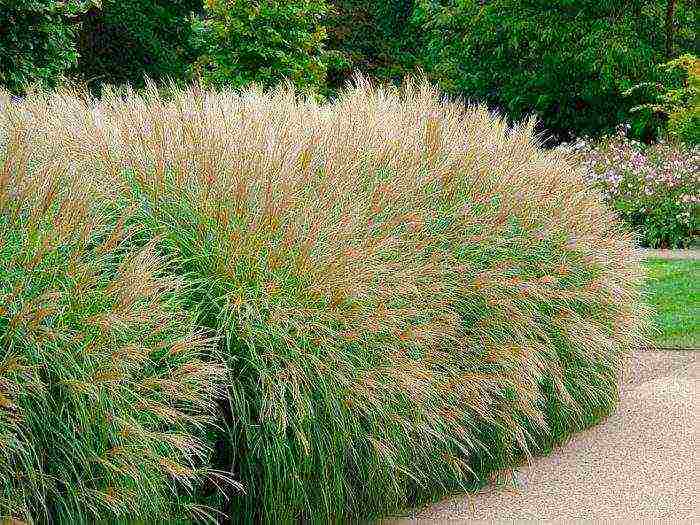
Miscanthus is a perennial plant and can grow in height from 0.8 to 2 meters. Its creeping rhizomes in some cases reach a depth of six meters. Stems are erect. The width of the leathery scaly leaf plates is from 0.5 to 1.8 centimeters.Spikelets are part of the fan-shaped panicles, which are 10–30 centimeters long. Such a plant is distinguished by its unpretentiousness, endurance and environmental safety. This decorative cereal is also used as a fuel for power plants, since when it is burned, a large amount of energy is released, and very little ash is formed, because the raw material contains a small amount of moisture.
Planting miscanthus outdoors
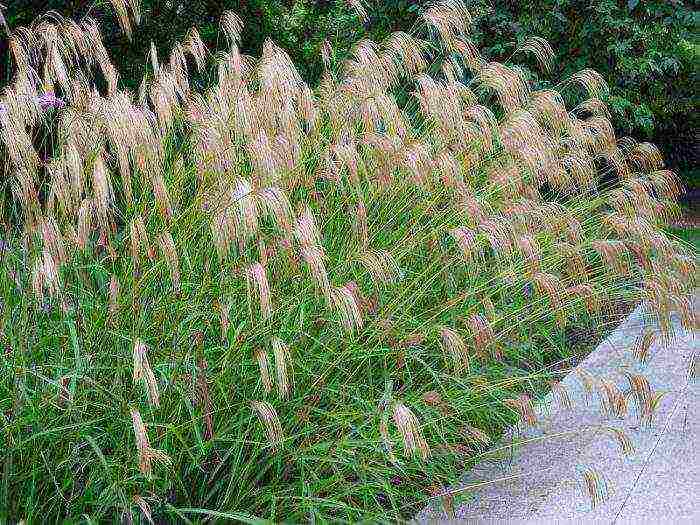
What time to plant
It is necessary to plant miscanthus in the spring after the soil warms up well (from the last days of March to the second half of May). This cereal is thermophilic; therefore, for planting it, it is necessary to choose sunny, well-heated areas that are protected from the cold wind. These plants need sufficient water and are best suited to moist nutrient soil located in the coastal area. Miscanthus does not have any special requirements for the soil, however, it grows and develops very poorly on heavy clay and sand.
How to plant
For planting, you will need to purchase adult seedlings from a specialized store. The fact is that this cereal has a rather long period of active growth. It should be borne in mind that such a plant starts growing only after the air warms up to 25 degrees. In this regard, if you plant a young seedling, then it simply does not have enough time to settle down well before the onset of frost and prepare for wintering. An adult seedling is able to tolerate even a frosty winter period normally, if it is provided with good shelter. The volume of the hole for planting should not be much larger than the size of the root system of the seedling. First, a layer of nutrient soil is poured into the hole, and then a seedling is placed in it. The pit is covered with soil, while constantly compacting it so that there are no voids left. The planted plant must be watered very well.
Caring for miscanthus in the garden
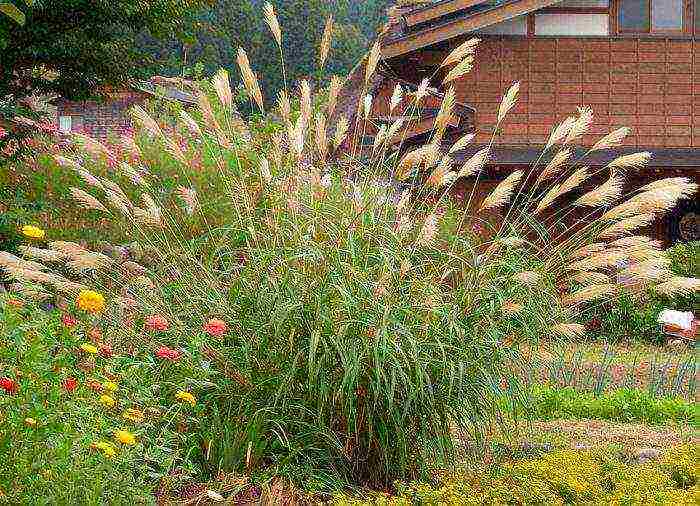
Miscanthus needs timely watering, otherwise it can dry out quickly. Particular attention should be paid to watering this cereal during a dry and sultry period. Hose watering is recommended for such a plant, while it should be as abundant as possible. In order for the ornamental cereal to grow and develop normally, it needs systematic feeding, which must be moderate, for example, an excessive amount of nitrogen can cause miscanthus to lodge. The planted cereals do not feed the first year. Then, in mid-May, liquid fertilizing with nitrogen-containing fertilizers is used (for example, a urea solution). In the first half of the summer period, plants will need watering with humates, and in the second, phosphorus-potassium fertilizer is applied to the soil. Also, the plant will need systematic weeding for at least two years in a row, then it will get stronger and grow strongly, so the weed on the site will stop growing on its own. It is not required to loosen the soil surface in the area with miscanthus.
It should also be noted that this cereal is a very aggressive plant that can grow and survive other flowers. Therefore, even during planting, special restrictions must be made; for this, limiters are used, in the role of which pieces of slate or sheets of iron can act. They should be dug along the entire perimeter of the site, while there should not be even minimal gaps and gaps. The limiters should be dug in at least 0.2 m deep, and they should also rise above the ground surface by about 10 centimeters, which will not allow the roots of the plant to "jump" over the border.
There are species in which, by the end of the summer period, the leaf plates located below are lost, from which the decorative effect of this cereal is somewhat reduced.In order to make the lower “bald” part of the miscanthus less conspicuous, it is recommended to plant a tall hosta (from 0.5 to 0.6 meters) in the immediate vicinity of it, which grows very well in highly moistened soil.
Almost any gardener can handle the planting of miscanthus, as well as its cultivation, and this cereal will certainly become the main decoration of any garden.
Reproduction of miscanthus

Such a plant reacts negatively enough to transplants, but after some time in the central part of the bush, the old stems begin to die off, and therefore the gardener thinks about replanting the miscanthus. As a rule, along with the transplant, the plant is propagated by dividing the bush. The division is recommended to be done in spring or summer time. It should be borne in mind that such a procedure must be done very carefully, because the restoration of this cereal after division takes a very long time and is painful.
Miscanthus can also be grown from seeds. Seeds do not need to be prepared before sowing, but if you choose this method of propagation, then you should take into account that you will have to be patient. The fact is that such a cereal grown from seed reaches the peak of its decorative effect only 3 or 4 years after sowing. It is recommended to sow seeds in individual peat pots, and after the soil warms up well in spring, the seedlings of miscanthus can be transplanted into open soil. However, it should be borne in mind that plants grown from seeds are not able to maintain varietal characteristics.
Pests and diseases
Such a plant has incredibly high resistance to a wide variety of diseases and harmful insects.
Miscanthus after flowering
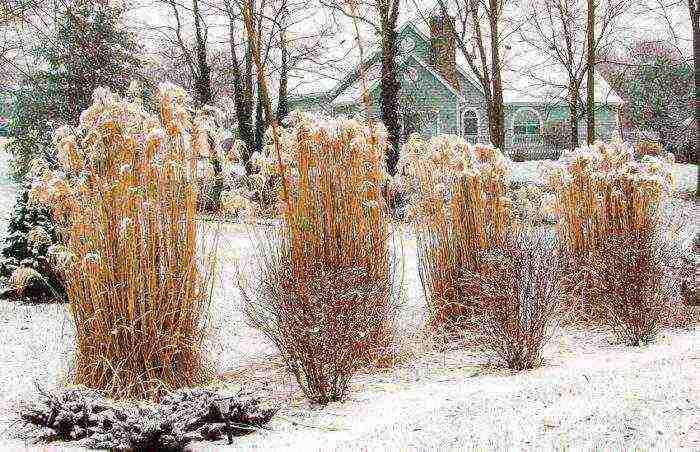
There are types of miscanthus that are frost-resistant, while others just need a good shelter for the winter. If you have planted a rather delicate variety of such an ornamental cereal, then you will have to provide it with protection from both frost and sudden changes in temperature. In the case when it gets colder outside gradually, the cereal can have time to adapt, but if the frost is unexpected, then the bushes in most cases die. In order to protect such ornamental plants, it is necessary to cover the bushes with a film, placing it in a hut, while air must be supplied from the side parts under the shelter. Then, on top of the film, you need to install 2 wood shields in the same hut. However, before covering the miscanthus, it is necessary to cover the area where it grows with a very thick layer of mulch, which can be used as any loose soil.
Types and varieties of miscanthus with photos and names
Miscanthus giganteus

This species has long been cultivated by gardeners, and experts believe that it is a complex hybrid, but no one knows how it originated. Erect shoots can reach a height of 300 centimeters. Weeping leaf plates are about 0.25 m wide. They are colored dark green, with a white stripe running along the central vein. From the escape, the leaves diverge in different directions, which outwardly is very similar to a large fountain. Flowering is observed at the end of the summer period, while light pink panicles appear, acquiring a silvery color over time. If the summer period in the region is cold, then miscanthus may not bloom at all. Often this species is planted as an accent in the background. It should be noted that at the end of the summer period, the lower leaves fade, in this regard, the lower part of the miscanthus will need to be masked.
Chinese Miscanthus (Miscanthus sinensis)
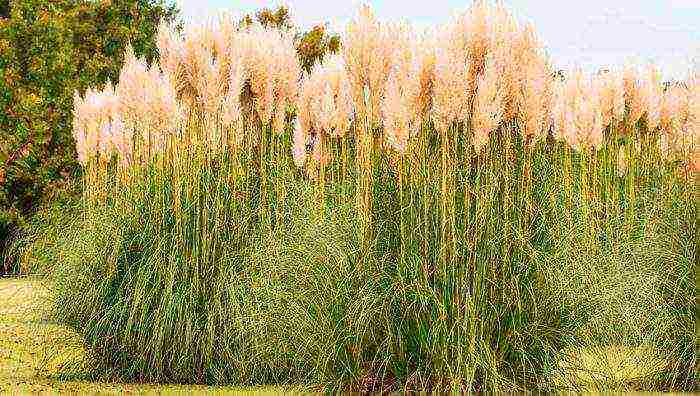
Under natural conditions, this species can be found in Korea, Russia, China, and also Japan. This perennial is a grass with a loose bush. He has a rather short rhizome, and erect shoots in height can reach about 300 centimeters.Rough rough linear leaf plates are about 15 millimeters wide, with a rough rib running along the central vein. During flowering, single-flowered spikelets appear, which can reach 0.7 centimeters in length, while they are part of loose panicles. It has been cultivated since 1875. It does not differ in high frost resistance, in this regard, it simply needs a dry shelter, while by winter one should not forget to sprinkle the area with a thick layer of mulch. This type is most popular among gardeners and there are about 100 of its varieties, which differ in the shape and color of the inflorescences, as well as in the shape and size of the bush itself. These include both frost-resistant varieties and those that prefer to grow in warm climates.
Varieties:
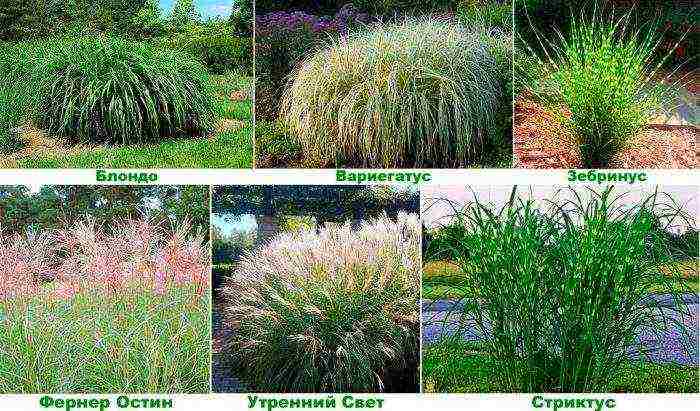
- Blondeau... It can reach a height of 200 centimeters. It is frost-resistant enough, no shelter is required for the winter.
- Variegatus... In height, a dense bush can reach only 150 centimeters. On its leaf plates there are longitudinal stripes of white color.
- Miscanthus Zebrinus (in some cases referred to as Zebrin miscanthus). The variegated bush on green leaf plates has yellow stripes that are located transversely.
- Ferner Austin... The bush can reach a height of 150 centimeters. On narrow green leaf plates along the central vein, there is a white stripe, which turns reddish-red in autumn. In August, fan-shaped panicles of a deep red color with white tops bloom, over time they change their color to bronze-silver.
- Morning light... A beautiful not very tall bush has narrow leaf plates with a white edging. Flowering is observed quite late and not annually.
- Strictus... The bush reaches a height of 2.7 meters, the width of its rich color of variegated leaf plates is about 15 mm. Green and rich white stripes are alternately located on the leaves, loose panicles consist of single-flowered pale red spikelets.
Sugar-flowered Miscanthus, or Sugar-flowered (Miscanthus sacchariflonis)
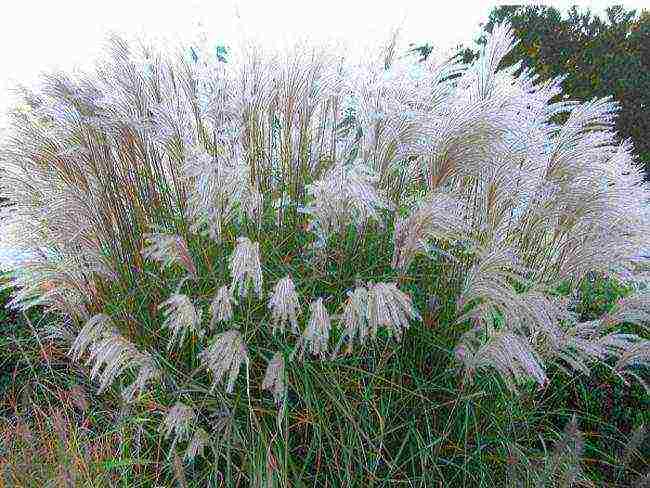
Under natural conditions, it can be found in Russia in humid areas from the south of the Primorsky Territory to the Amur Region, as well as in China, Korea and Japan. In height, a bush with bare shoots can reach 200 centimeters. The drooping linear leaf plates are painted in a pale green color, they are one and a half centimeter wide, and about 0.6 m long. Panicles reach 0.25 m in length, and they are painted in white or pink-silver color. This species belongs to the thermophilic species, therefore, its growing season begins at the end of the spring period, however, its growth is highly intensive throughout the warm season. Flowering begins in July, and such a cereal can maintain its decorative appearance until October. It is frost-resistant enough, no shelter is required for wintering, but it is better to mulch the site in case of a little snowy winter period. The most popular form is Robustus; it has a slightly larger bush than that of the main plant.
Chinese miscanthus is one of the most famous ornamental cereals. In nature, it can be seen in the countries of the Far East, Japan, Korea and China. Among the gardeners of the world, there are other names for this plant - "Chinese reed", "fan".
What is a plant
Miscanthus is a potent perennial herb with a short rhizome. The height of its bushes is from 60 to 200 cm. They have rigid erect stems, the lower part of which is covered with long leaves. Their hard surface is varied in color. The leaves, which are about 2 cm wide, are very rough to the touch.
Miscanthus Chinese has single-flowered spikelets. The place of their placement is loose, shortened, fan panicles.
There are more than 100 varieties of miscanthus in the world. Not many of them have taken root on the territory of our state.Many species of this plant, despite careful care and shelter, freeze in winter.
Using miscanthus
In ornamental gardening, miscanthuses are most often used to decorate the shores of water bodies. It also looks very good in mixborders. Moreover, it can be used both separately and in group plantings.
Almost all varieties of miscanthus have a rather long decorative period, which begins in early spring and lasts until the onset of cold weather. In autumn, the leaves of this ornamental plant turn yellow, red and brown.
Cut flower inflorescences are used when they are fully ripe and fluffy. Also, with the help of this plant, the wings are created.
The big advantage to using miscanthus chinensis is its ability to keep its shape. Most of its species look like a solemn upright bush that grows rather slowly. Other varieties are more aggressive - they quickly grow in breadth and clog neighboring plants.
Miscanthus Chinese: planting and care
Miscanthus is not very picky about the soil. But during planting it is necessary to avoid places with sandy or heavy clay soil.
Caring for this plant is relatively uncomplicated. In order to prevent unwanted intensive growth, during planting, you should artificially restrict the plant. The restriction should be placed along the perimeter of the planting and have a depth of at least 10 cm. But it does not need to be deepened too much, since the plant has a superficial root system. The top edges of the restraint should be placed about 5 cm above the ground. This is due to sufficiently strong roots that can pass a low barrier.
If the Chinese miscanthus has formed a dense kut, it may begin to die off in the center. The main reason for this is the delay in the timely division. This decorative cereal must be periodically divided and planted.
Top dressing should be carried out only minor. If there is an excess of nitrogenous fertilizers, the plant will grow very quickly and fall on the ground.
Prune miscanthus chinese should be in early spring, because its shoots have a decorative look even in the autumn and winter seasons. It should be regularly removed processes that do not have such a decorative appearance as the bush itself. This plant does not like transplants very much - therefore, the best option would be to provide it with a permanent place in the garden.
Reproduction
There are two ways to breed miscanthus:
- seeds;
- dividing the bush.
It is necessary to divide the bush in early spring. This work must be done very carefully and carefully, since miscanthus does not like manipulations associated with transplantation.
For propagation by seeds, it is necessary to sow them under winter. They do not require pre-processing. If you prefer this particular breeding method, please be patient. This bush will acquire its natural beauty only after 3-4 years.
In order to minimize injury to the roots of the plant, the seeds are first germinated in pots. And only after the onset of spring and the complete thawing of the soil, they are transplanted into open ground.
During the cultivation of miscanthus from seed, there is no retention of varietal traits. Therefore, another type of reproduction is more popular - division.
Miscanthus groups
Chinese miscanthus are usually divided into three groups, depending on their height.
- Low-growing - graceful bushes with thin leaves, reaching 150 cm in height. Most often they are placed in the front rows of a flower bed or flower garden. They also land in the rock garden.
- Medium-sized - the most common varieties, reaching 180 cm. In the garden, they are in most cases located in neat groups or independent hummocks.
- Tall - their height is more than 200 cm. They are placed in the background.Most of the representatives of this group bloom only in warm climates.
Miscanthus varieties
Today, miscanthus is very common. There are more than 100 varieties of it. They can be distinguished from each other by the shape and color of the inflorescences. It is pure white, pink, brown, with a burgundy tint. Also, varieties differ in color, shape and size of leaves. There are graceful thin, curved and upright leaves, painted in a wide variety of shades.
Among the main differences, one of the main places belongs to the size and shape of the bush. Also, an important role is played by adaptability to a variety of growing conditions and weather and climatic zones.
The conditions in the middle lane are ideal for growing these varieties.
- "Blondo" - the height of the bush of this cold-resistant plant reaches 2 meters.
- "Flamingo" is a tall miscanthus with large inflorescences and beautiful spreading leaves of pink shades.
- "Grosse Fontane" - also belongs to the group of tall plants, has lush green leaves and a densely standing bush in the form of a fountain;
- "Hinjo" is an ornamental variegated bush with leaves painted with horizontal yellow stripes.
- "Variegatus" - has leaves with bright white longitudinal stripes.
- "Kleine Fontane" is a member of the stunted Miscanthus group with a deep reddish brown color and very lush bloom.
- Miscanthus Chinese "Morning Light" is most suitable for growing in containers. Its main feature is narrow leaves whitened along the edges and a reddish inflorescence.
- Chinese miscanthus "Zebrinus" refers to tall plants, since the height of its bushes reaches 250 cm; cream-colored stripes are placed across its leaves.
- Chinese miscanthus "Strictus" is a very tall plant (up to 270 cm), having a columnar shape, transverse white stripes are located on the leaves, and the inflorescences have a reddish color.
Chinese miscanthus "Purpurascens"
Chinese miscanthus "Purpurescens" at the peak of its beauty acquires a bright crimson color. And during the flowering period, the bush is covered with silvery inflorescences. The long leaves of this plant resemble brown needles in their appearance.
This variety of miscanthus can be planted in small, thorny islands in a chaotic manner. They will also look good along the curb. They are used to mark the boundaries of the flower bed.
When planning the placement of this miscanthus variety, its meter height must be taken into account. And in order for the plant to look like a frame, taller flowers should be placed in the flower bed.
Breeding it is so simple that even a beginner can handle it. When caring for the Chinese Purpurescens miscanthus, do not forget about frequent watering.
Miscanthus "Strictus"
Chinese miscanthus "Strictus" has a relative frost resistance. It is a powerful short-rhizome cereal plant with erect stems, leafy in the lower part. The height of the bushes reaches 180-270 cm, and the width is 45 cm. The leaves have a linear shape. They have a thick rib in the middle, and a large number of transverse white stripes on the surface.
The flowers look like single-flowered spikelets of reddish color. These are loose panicles, 0.7 cm long. They bloom in early autumn.
As for cultivation and care, waterlogged areas are ideal for Miscanthus "Strictus". But it can also be grown in relatively dry places. Although in this case it does not grow so much.
This type of cereal is not picky about the soil, but prefers fresher. It grows poorly in clay and sandy areas.
Growing miscanthus in the garden
It is not so easy to successfully cultivate miscanthus in your garden. Growing it involves observing some mandatory rules.
- During the selection and purchase of seedlings, preference should be given to adult planting material.This is due to the peculiarities of our climate, which is unusual for miscanthus. Therefore, he needs more time to go through the growing season. Otherwise, a small seedling simply will not have time to get stronger and will not survive the cold winter.
- The landing site should be sunny and sheltered from the winds.
- A planting hole is required with fertile, sufficiently moist soil.
- Organization of regular watering.
- Mulching the root zone of the bush, as the plant does not tolerate drying out well.
- Providing annual feeding with organic fertilizers in the spring season.
Winter miscanthus care
It is advisable to cover miscanthus for the winter. In particular, non-resistant varieties and those that were planted in cold areas need this. This cereal gradually adapts to a slight decrease in temperature. But its sharp drops can provoke his death.
You can cover it with garden film. In this case, do not forget to leave space on the sides for ventilation.
The climatic zone of the middle zone is characterized by the fact that it is possible to divide Chinese miscanthus here only in spring or early summer. Planting and care suggests that after this process it takes several years for this plant to reach its maximum decorative effect.
A tropical cereal plant, miscanthus is successfully grown in our difficult conditions. Breeders have bred varieties that are zoned for planting in all regions of the country. Thanks to his work, each grower will be able to grow a 2-meter giant that can decorate the design of a garden plot.
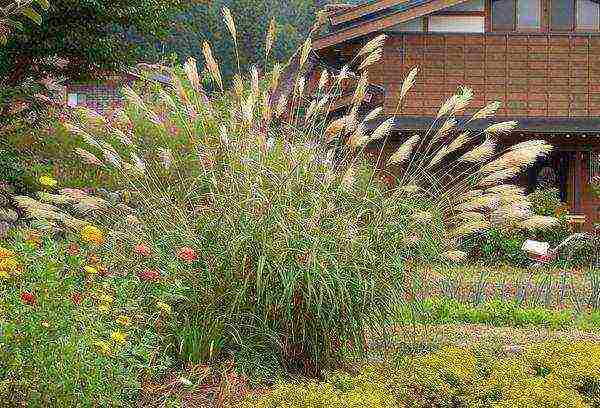
Short description
First, let's get acquainted with the overseas flower. Its main data are shown in the table below.
Table. Features of miscanthus
| Root system | Perennial flower with a branched horse system. In dry periods, the roots penetrate underground to a depth of 6 m |
| Bush height | Certain species and varieties stretch up to 80 cm or 3 m. When choosing seedlings, be sure to take this characteristic into account! |
| Plant structure | The bush consists of strong and strong shoots, which give it a spherical or brush-like shape. |
| Foliage | Lanceolate-linear foliage, reminiscent of a weeping willow, grows at the bottom of each stem. It hangs freely, forming a stream of a waterfall. Leaf width - up to 20 mm. Coloring - green, with a longitudinal white stripe running in the center. The surface is dense, with peculiar scales |
| Flowers | In the middle of the bush, 30-centimeter flowering shoots sprout, at the tips of which inflorescences bloom, resembling panicles and up to 70 mm long. At the very beginning, the panicles are colored pink, but gradually the hue changes, and the flowers become silvery. The beginning of budding is the second half of July, but during a cold summer, the plants may not bloom |
Miscanthus, with good care, develops quickly and increases the mass of shoots.
Grown to decorate the shores of garden ponds and lawns. Depending on the variety, it is resistant to cold or not. Heat-loving miscanthuses are stored in a cool and humid room in winter.
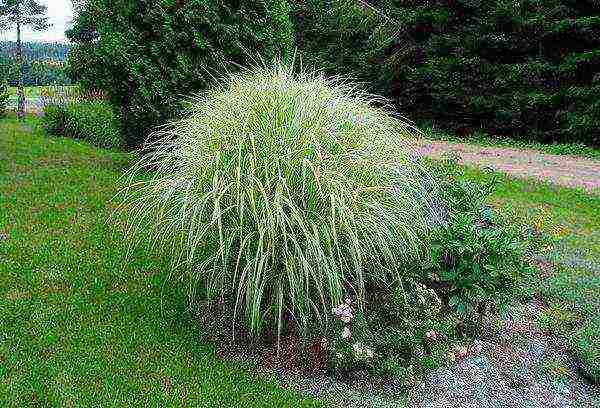
Important! When choosing a variety, be sure to consider its winter hardiness. Some varieties will need to be brought into the house.
Reproduction methods
As a rule, miscanthus settles by dividing the bush. Seed propagation is also used, but this method is fraught with a number of difficulties:
- cold winters and short summers do not allow growing strong seedlings;
- the decorative properties of the mother plant are lost, and the development time of an adult bush is stretched for 4 years;
- it is difficult to collect seed material from mature plants (the seeds are very small).
Only recently have several varieties of miscanthus been developed, from which the seed is collected. Such varieties are not used for decorative purposes, adult plants are used for fuel thanks to strong stems.
Sowing begins in the fall, planting seeds in seedling boxes.Then the sprouts are separated and planted in separate pots. Only in the middle of spring can the grown seedlings be relocated to a school.

The main method is by dividing the mother bush
We use only three-year-olds, such bushes have a strong root system. We start only after the start of the growth of young shoots, in March-April, and for the middle lane - in May-June.
We carry out the work in several stages:
- choosing a bush, mark out a wide circle and begin to carefully dig out the bush, try to damage the roots less. This work must be done before planting the seedlings, or the seedlings must be placed in a cool, damp place;
- using a sharp knife or pruner, we divide the mother bush into several seedlings. Be sure to cut off all the shoots, this will allow the plant to take root, food will go to the development of the root system;
- after that, we plant the daughter bushes in place.
Do not be alarmed if at first the seedlings are lethargic and sick. Slight developmental delays in the first weeks are normal. The roots are just beginning to penetrate the soil and the plant is not getting enough nutrition. Therefore, it is important to maintain moist and loose soil under the bush and remove leaves and shoots.
Landing place
When choosing a place, pay attention to the areas:
- with a good level of lighting. It is not recommended to plant miscanthus even in a slightly shaded place, here the heat-loving plant will lag behind in development;
- moist, but not swampy. If groundwater passes close to the surface, long roots will be able to independently provide the bushes with water;
- protected from drafts or constantly blowing wind.
Important! When choosing a placement, be sure to consider the miscanthus variety and how it will look next to other plants.
We plant tall miscanthuses so that they serve as a background, in front of which we plant undersized bushes and flowers. We plant medium-sized varieties on a grassy lawn, together with other flowers.

Soil requirements
Although miscanthus is not picky about the soil, if the soil on the site is clay or completely sandy, it is better to plant other flowers here. If you want to place miscanthuses here, you will have to add a sufficient amount of humus and sod land.
We begin to prepare the soil for planting in the fall. To do this, we dig a hole 500-600 mm deep. With a high level of acidity of the soil, add dolomite flour. To ensure the root subcortex, mix in equal parts humus, compost and sod soil. We fill the bottom with a layer of expanded clay or broken bricks and completely fill the hole with prepared soil.
During the winter, the soil will be well saturated with water, in the spring it will only be necessary to select a little soil from the hole and plant a seedling.
Requirements for seedlings and planting bushes in open ground
We will analyze the main questions on the choice of seedlings. Be sure to take into account several factors:
- If you decide to buy ready-made, adult miscanthus seedlings, be sure to go to a specialized garden store or plant nursery. We buy an adult bush. Young grown seedlings will not be able to develop in a short warm period and will die.
- Be sure to inspect the bushes before buying. The plant should be free of damaged, sluggish roots and stems or signs of exposure to powdery mildew and other diseases.
- We check with the managers the winter hardiness class of the variety. Chinese and giant miscanthus with 4-5 frost-resistance zones are suitable for our conditions.
Landing procedure:
- The hole volume should be 3 times the size of the root system. Selecting some land.
- Fill the hole with water and place the seedling in it.
- Carefully, in small portions, we begin to fill the hole with earth, periodically pulling the bush up a little.
- We do not fill up the earth to the very top, we leave 50-60 mm. We fill this space with a layer of mulch using peat, sawdust or deciduous tree bark.
The planting process is over.The time has come to perform simple plant care operations.
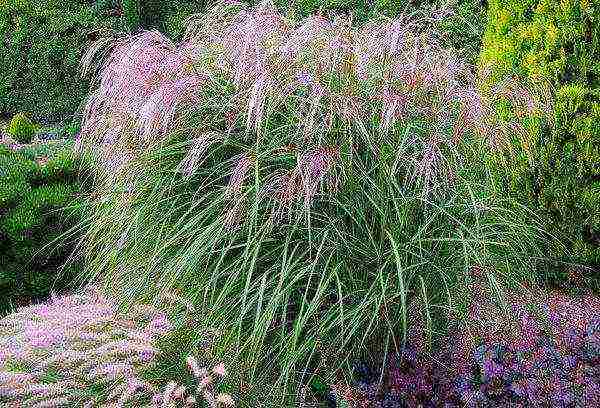
Care requirements
Caring for miscanthus is an important manipulation for the growth and development of tall and beautiful bushes. They will not take much time and effort, but it is important to treat them carefully and responsibly:
- Bushes are demanding for watering. You cannot water the plants with cold water from a well - only warm water heated by the sun gives the plant enough nutrition. In the first days of the growth of seedlings, we water them daily, but in small portions. It is especially important to do this during hot periods.
- After each watering, be sure to loosen the soil and add a layer of mulch. We do not drive the chopper deeply, we loosen only the top layer of mulch and soil. The root system is close to the surface, so it is important to follow this rule.
- When planting, we supply the bush with a post for tying the stems. Depending on the variety, it may be necessary to prepare a 2 meter support.
- For proper development, we provide the plant with regular feeding. We begin this work in the second year of the growth of the bushes (in the first year, they have enough nutrition from the fertilizer applied before planting).
- For protection in winter, we make wooden shields and set them up as a hut. Cover the top with a covering material. Such protection will allow air to pass through for ventilation of the bush and will not allow the plant to rot and mold during winter thaws. Such protection is required only in the first 2 years, then the bush will fully adapt to winter conditions. But this rule does not apply to thermophilic miscanthus varieties.
The order of feeding, starting from the second year:
- at the beginning of active growth, we feed Miscanthus with urea or other nitrogen fertilizer;
- in June we carry out the second feeding of the plant, you can add a ready-made complex fertilizer with a high humus content;
- in August-September we apply root dressing based on potassium-phosphorus fertilizers.
The rules are simple, the care and planting work does not require much time and effort. But the reward for lovers of miscanthus will be a 2-meter beautiful bush with green foliage, pink and silver flowers. The main thing is to love your job.
